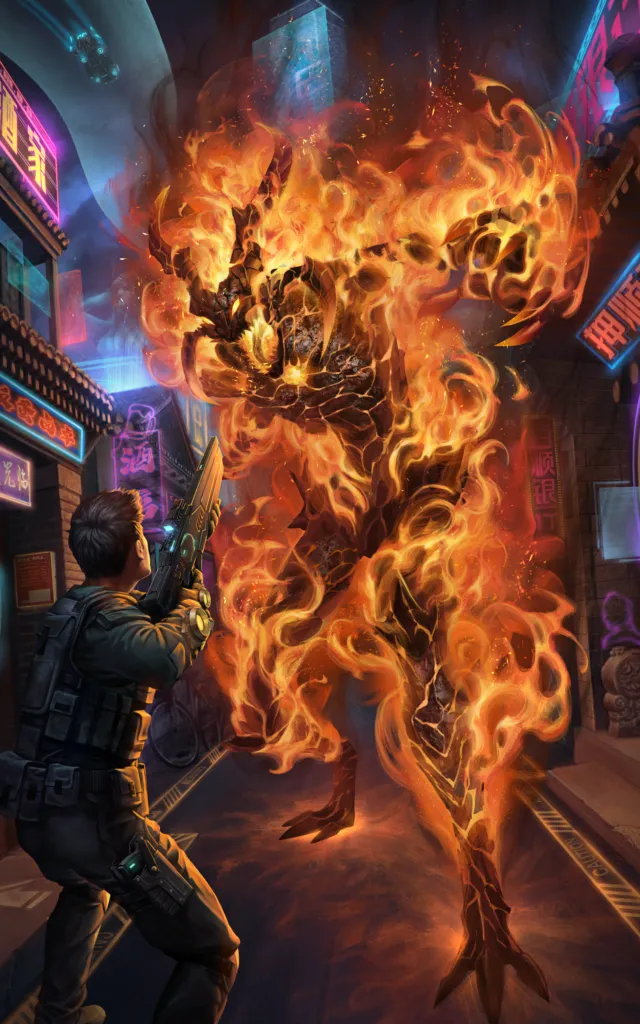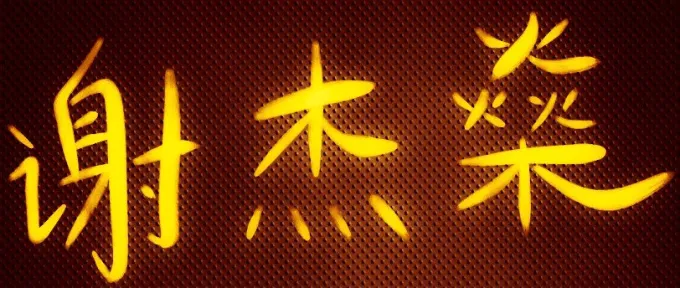
The romance of the jianghu crosses borders and cultures. It is freedom from cultural strictures, skill with martial arts, an iron code of honor. In China, its greatest appeal comes from its sharp contrast with Confucian norms, with its emphasis on rigid social hierarchies and complex etiquettes. The West sees parallels with the knights-errant of old, and the cowboys of the Old West.
The word wuxia carries a distinct moral imperative. In Chinese, it is written as 武侠. 武 is composed of two characters, 止 and 戈. 侠 is the simplified form of 俠, which is written with the radicals 人 and 夾.
止 means ‘stop’, while 戈 is a dagger-axe, an ancient Chinese polearm. 武 therefore means to stop the dagger-axe. Where 'martial art' means the art of Mars, the god of war, the word 武 has an inherently noble and defensive purpose.
人 is a man. 夾 is the character used for ‘wedge’ or ‘insert between’. 夾 shows one person holding two others under his arms, two people sandwiching a third, or one man standing in front of two others. 侠shows a man who shields others with his body—which why is the word is translated as ‘knight’ or ‘chivalrous person’.
What does 武侠 mean? A man who stops the dagger-axe by placing himself between the weapon and the innocent.
The term xianxia has a related meaning as well. ‘Xian’ in Chinese is 仙. It shows a man who goes up a mountain. He does this to meditate, to cultivate, to escape the red dust of the mortal world. Such a person would be a hermit, not a hero. Why would he ever climb down the mountain?
To use his powers and abilities for good. To stop the dagger-axe and protect the innocent.
Wuxia and xianxia are inherently noble callings. Instead of ‘knight’, I would insist that the Western equivalent is paladin. A knight is merely someone granted a title of knighthood. It is a social class, not a statement of morality, as the robber knights of the Rhine demonstrate. A paladin is a heroic champion, a protector of the innocent, and a defender of the faith.
What does wuxia and xianxia fiction mean today?
A power measuring contest.
In some measure, it reflects historical reality, and the reality of living in China. It wasn’t always so. It doesn’t have to be so.
For much of its history, China was in a state of turmoil. Wars, uprisings, invasions, bandit attacks and pirate raids were commonplace. Martial artists had little interest in cultivation. They were soldiers, constables, bodyguards. What use had they for higher thoughts when they risked their lives day after day? Their chief concern was survival on the battlefield.
The earliest records of Chinese martial arts date to the Ming Dynasty. Most of those manuals pertain to archery, cold weapons, and grappling—skills most useful for the battlefield. Unarmed arts weren’t emphasized. For example, General Qi Ji Guang developed the Thirty-Two Fist Stances for his troops, not to teach them how to fight with empty hands, but merely as a means of exercise and to cultivate confidence and aggression.
The idea of cultivation and martial arts joined as one was a relatively new concept. What we call cultivation today originates from religious qigong: qigong methods practiced by Buddhists and Daoists. Monks and hermits had little to do with warriors, outside of martial monasteries like the Shaolin Temple.
It is said that when Indian monk Bodidharma visited the Shaolin Temple, he laid down a tradition of martial arts practice alongside meditation and Buddhist lessons. He also passed on the Yijin Jing and the Xi Sui Jing, two of the most famous cultivation texts in history. History records that bandits and thieves targeted Shaolin Temple and its vast holdings, causing the monks to organize militias to repel them. Martial arts experts and retired soldiers regularly visited the Shaolin Temple as well, passing on their martial knowledge to the monks.
Martial qigong methods were developed by martial artists to cultivate strength and power. Religious qigong, on the other hand, was kept secret, transmitted only to high-level disciples committed to the path to enlightenment. Only relatively recently were the Yijin Jing and the Xi Sui Jing taught openly to lay students.
The marriage of martial arts and religious qigong—in other words, modern-day martial cultivation—occurred in the Qing dynasty. During this time, the nation was mostly at peace. Wars were fought against European powers with guns and cannons. Bows, spears and swords were mildly useful secondary weapons at best, irrelevant at worst.
Martial arts were no longer used for war. While there was still a need for self-defense against the numerous bandits prowling the roads, the life of the nation did not rest on traditional martial arts. This allowed deeper exploration into the psycho-spiritual aspects of martial arts, especially among the internal martial arts.
Sun Lu Tang, founder of the Sun Style of xingyiquan, baguazhang and taijiquan, popularized the concept of martial arts as a form of cultivation. His martial arts manuals made heavy references to Daoism, qigong and metaphysical concepts. He saw his arts not simply as a means of self-defense, but also as a method of cultivation.
The historical origins of familiar jianghu tropes emerged during this period as well. Baobiao, professional bodyguards, escorted merchants and government officials across the land, fighting off bandits and secret societies wherever they went. Martial artists underwent pilgrimages to study from renowned masters, and challenged other fighters to prove the superiority of their arts. Losing a challenge meant the end of a person’s professional career as a baobiao, martial arts instructor, or other violence professional. Government officials hired renowned martial artists as military officers or law enforcement officers. Some martial artists built their reputations on defeating bandits and arresting criminals. Others became the leaders and cornerstones of their community, offering help whenever the government failed to assist.
The rivers and lakes was a dangerous world, filled with violence and vendettas. Those who lived as violence professionals in that time had to be prepared to fight at a moment’s notice. Not only that, but they also had to contend with law enforcement as well, which attracted another host of problems. Yet it was also a world of honour and ethics, where a man lived and died by his word and his skill at arms.
The wuxia novels of the twentieth century were written during one of the most turbulent periods of Chinese history. The downfall of the Qing Dynasty, the rise of the Nationalists, the Sino-Japanese War, the Chinese Civil War. The May Fourth Movement of 1919 called for a break from Confucian values. The fables of the xia and jianghu emerged during these times, perhaps because of their emphasis on freedom, defiance of tradition, and rejection of the old ways.
The genre reached a golden age during the 1960s to 1980s—during the Cultural Revolution and the immediate aftermath. China was in the grip of a Chinese Communist Party seized with revolutionary fever, with the Red Guards rebelling against the old ways to solidify the power of the Establishment. The Kuomintang ruled Taiwan under martial law. Hong Kong, though safely under the British umbrella, experienced turmoil and corruption of its own.
Against this backdrop, wuxia stories can be seen as part of a cultural dialogue to determine the future of the nation: a future of individualism and autonomy, or autocracy and rule by diktat. It could even be argued that writing about a fictionalized ancient China was a way to bypass official censorship while still communicating key ideas.
From the idealized vision of the past, the development of martial arts in the Qing Dynasty, and the historical backdrop of the 1960s to the 1980s came many of the tropes we now see in wuxia fiction.
We do not live in 1960s China. We live in 2021. And yet, history is repeating itself.
We live in a time of spiritual dissipation, societal decadence, and a steady march towards global autocracy. The spirit of the Red Guards have reincarnated in Antifa and Black Lives Matter. Corruption is still prevalent. Organized criminals are still everywhere, only this time they have access to better technology and firepower. Self-aggrandizement, hedonism, and the pursuit of wealth and power remain timeless vices.
Now, more than ever, wuxia and xianxia have become increasingly relevant as vehicles for positive social change. Yet so many authors, Chinese and Western alike, used the genre simply as a means to reinforce the spirit of the age.
No more.
Saga of the Swordbreaker is my homage to the wuxia masters of the past, and an interpretation of the times. It is a vehicle for breaking the swords forged by the wulin of pseudo-cultivation, the vices and the decadence espoused by what passes for ‘cultivation’ fiction today, and from the shattered steel it seeks to create a better tomorrow.
What is the way of wuxia? To stop the dagger-axe—if necessary, with your life.
What is cultivation? Purification—and through purification, transcendence.
At its heart, Saga of the Swordbreaker is a return to nobility, and a quest for purification. To walk the way of the wuxia, back the series on IndieGoGo here!
